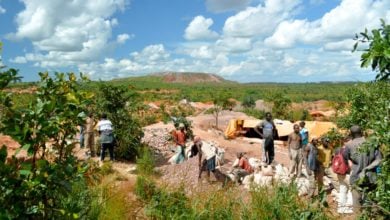Photo: Swaziland National Union of Students president Colani Maseko speaking to a demonstration delivering a petition to parliament. Credit — Swaziland Youth Congress
After half a century of brutal rule by an absolute monarchy and determined popular struggle, a new wave of pro-democracy resistance in eSwatini, formerly known as Swaziland, may be on the verge of finally bringing the kingdom down. In recent weeks, thousands of protesters have taken to the streets in the most significant mass uprising eSwatini’s King Mswati III has ever faced.
Sandwiched between South Africa and Mozambique, two-thirds of residents languish in poverty. When the country gained independence in 1968, the British imperialists arranged for post-colonial rule to go to a hereditary monarchy willing to secure their business interests. Life expectancy averages only 51 years. The coronavirus pandemic made a bad situation worse. With popular frustration building up in recent months, the elites wedded to the institutions of the absolute monarchy — and especially the king himself — continued to enjoy their extravagant lifestyles.
Protest movements demanding political or economic reforms are not new in eSwatini. They are routinely confronted by the monarchy’s repressive security forces, which eat up 12.4 percent of the country’s budget – more than what is individually allocated for health, education or social services.
In May, security forces were accused of killing and torturing a young law student, Thabani Nkomonye, and then covering it up. This sparked the recent protests. Calls for police accountability, fueled by widespread economic misery, quickly broadened into demands for democratic reforms.
The state responded with repression, as it did during anti-monarchy protests in 2011, 2018 and 2019. Police attacked Nkomonye’s memorial service in armored vehicles, firing teargas and rubber bullets at mourners. Organizers were arrested. This inflamed the movement and protest activities quickly spread around the country.
Thousands of protestors began marching on local government centers in the country’s 59 constituencies to deliver petitions calling for reform. Many actions were organized by activists from the People’s United Democratic Movement (PUDEMO) and the Communist Party of Swaziland. Both groups are banned and constantly attacked by the government, but are courageously continuing their activity.
Police responded with live bullets and on June 24 the government decreed all marches to deliver petitions banned. Infuriated, protestors continued to march despite the ban. The absolute monarchy issued a strict night curfew, switched off internet services creating a communications blackout, and deployed military and police around the country to brutally empty the streets. Protestors set up road blocks and business interests owned by the monarchy went up in flames. Scores of people have been killed during the King’s crackdown. Hospitals everywhere were overrun with gunshot injuries inflicted by security forces.
The United States, which has a cordial relationship with the monarchy, issued a bland statement for royal authorities to “exercise restraint.”
In eSwatini, all authority is based on the King who is head of the monarchy. The royal family owns and controls over half of the national economy. The King appoints 10 out 65 members of the house of representatives, 20 out of 30 members of the senate, and can veto any law. He handpicks all judges and magistrates, the Prime Minister, Cabinet ministers, members of the Public Service Commission responsible for recruiting civil servants, and other bodies.
Although the political and economic dictatorship of kings and appointed chiefs is presented as “traditional,” it is actually a creation of the colonial period. The territory that is now eSwatini was formally annexed by the British from 1906 to 1968. The British partitioned the peoples’ land militarily, stealing two-thirds of the most arable land for themselves. The colonial administration ended up forging an alliance with a weakened Swazi monarchy, in part to deal with competition from earlier and more numerous European settlers, the Boers, who were trying to establish themselves as the principle colonial rulers of southern Africa. This marked the real beginning of a modern Swazi monarchy endowed with absolute powers and propped up by outside forces.
In the run up to independence, with revolutionary anti-colonial movements on the march across Africa and the whole world, neither the British imperialists nor their Swazi royal allies favored democratic rule. The British feared that democratic takeover by Africans, many organized into politically influential trade unions, might lead to the expropriation of their ill-gotten gains. Swati royal elites also feared that progressive African freedom fighters might upend their dictatorial power.
When eSwatini gained its independence in 1968 it was the royal aristocracy with the political backing of white settlers that the British eased into power. The absolute monarchy consolidated its powers in 1973 by banning all political parties and activity, a ban that remains in place today. In fact, this prohibition was recently reinforced by the 2008 Suppression of Terrorism Act, which provides legal cover to punish anti-monarchy dissent.
Protests are ongoing, as is repression from the King’s forces. For instance, on July 4 two South African journalists covering the uprising were arrested and tortured by police. As atrocities pile up, pressure is mounting on the neighboring countries in the Southern African Development Community to increase pressure on the monarchy.






